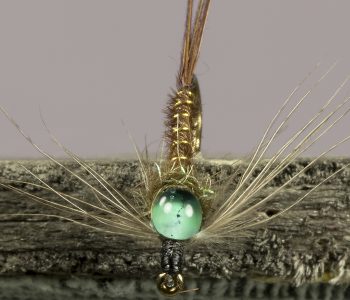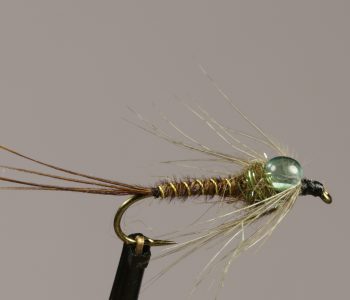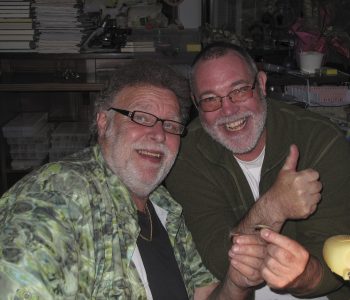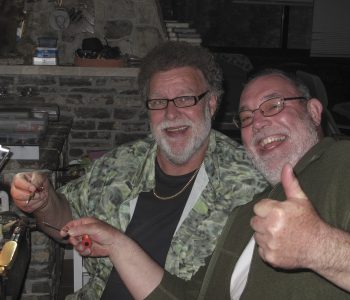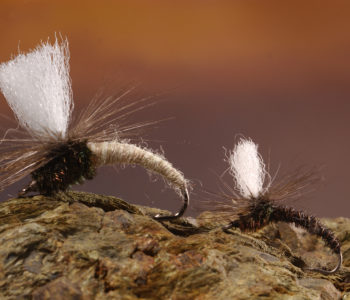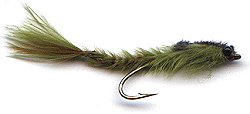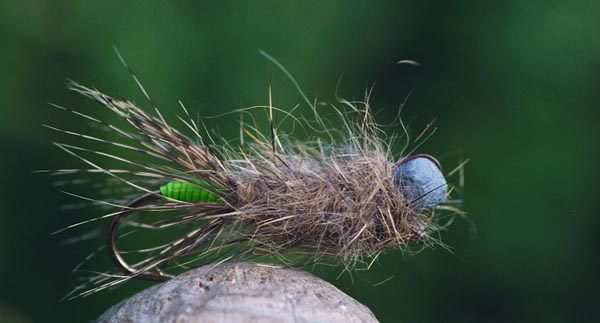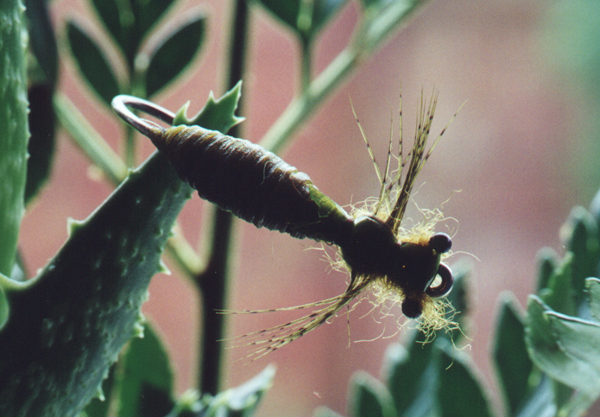
The Leadhead Story
A BUG FOR THE DEEPS
Fishing the dry fly for grayling and trout is my passion and I prefer it to any other method. I get a greater thrill out of seeing fish coming up to take my fly on the surface than I do from nymphing or any other kind of wet-fly fishing. Sadly dry-fly fishing doesn’t always work. Sometimes, it is necessary to use unweighed nymphs, flymphs or emergers for fishing just under the surface in order to be successful. The worst thing that can happen to a dry-fly fisherman, however, is when fish are lying right down on the bottom, or are feeding in deep lies. In these circumstances my leaded bugs can be successful, or at least worth a try.
The leadhead is probably the most successful deep-water nymph I have ever used. There were many modifications and changes made to the original before I arrived at the dressing I use today. Originally designed for the large, deep and swift rivers of Scandinavia, it has since to prove well in many other rivers too.
NEW FISHING GROUNDS, NEW FRIENDS
During my first years as a fly fisherman, I only fished with dry fly and it took me some years to discover the value of nymphs. When I first developed my own nymphs, I never guessed how much satisfaction and pleasure fishing with a nymph would lead to. I developed the leaded bugs especially for grayling feeding in deep lies. Before 1980, I only tied a few nymphs for fishing in Holland and to practice my tying skills and, because of the good results I had been getting with the dry fly abroad; I was seldom prompted to use them.
During one of my summer holidays in the early eighties I met some Swedish fly fishing fanatics at the Glomma River in Norway. I usually fished in the areas around Koppang, Atna and Alvdal, but the interest in new fishing grounds and fishing pressure drove me further upstream. I found a nice camping place between Tynset and Os named Knennan, located in an area described as one of the best grayling waters in Europe. Unfortunately it was crowded at that time, mainly with Swedish fisherman but everyone was friendly to us so we decided to stay and see how things turned out. It was a good choice and in less than one hour after putting up our tent I had befriended a group of fly fishermen who already fished a couple of days and knew exactly where, when and how to tackle the river. When they invited me to accompany them during their nightly trip, I realised that this was the beginning of a completely new experience.
FAVOURITE BEAT
With this group, I fished one of the most beautiful stretches of the river. After several years of fishing this beat has become one of my favourites; I call it Otter Creek. Every time I have fished this stretch I have seen otters, they were unbelievably curious and a good company during the lonely nights. They actually never disturb my fishing and were more one of the aspect of the fantastic wildlife in this area of Norway.
Lars one of the group members, used to fish with very heavy nymphs and this especially caught my attention. He was the only one who fished below the surface, and he did so with considerable success. I had some interesting discussions with him, as I was very eager to learn.
The killing fly Lars was using, he called his Kvennan Special. It was named after the camping place that he had stayed and fished for more than 15 years.
One evening, after a bitterly cold and rainy day when the dry fly had not been nearly as successful for me as usual, Lars invited me to his caravan and were we exchanged some fly patterns. He also gave me an excellent tying demonstration of several of his own kind of bugs. I regret that I did not make proper notes on that occasion: I am sure many anglers would love to hear about my Swedish friend’s marvellous patterns.
Lars was a very good teacher and his techniques were simple and effective. Because of the success with his nymphs I tried to copy the pattern and after a few attempts a reasonable one was born. I showed my “Kvennan Nymph” to Lars who was very complimentary. At that time I only had been tying a few years but I am sure his help instilled confidence in me and was probably instrumental in the development of the nymphs I tie today. The Kvennan Special is still one of my favourites but more importantly, it is also the fly that gave me the idea for a very successful series of patterns that I devised myself.
I first tied my own weighted nymphs during the winter after I had been introduced to the Kvennan Special. The nymphs were tied using layers of leadwire to weight them. The materials Lars used for his fly were not available in Holland, but I found some satisfaction in using rabbit fur and partridge feathers. My first nymph I called Lars’s Grayling Bug and it did very well.
IMPROVEMENTS
In a year of experiments with this variation of the Kvennan Special I tried to bring some improvements to the fly: I left out the tail and moved the body hackle much closer to the hook bend. A smaller tag in the same colour as the original pattern still existed, but it was not long before I did some colour experiments with the tag too. The fibres of the partridge tail feather gave a nice long tail and very good action. Today I consider this idea to be one of the best in my development of grayling bugs.
Many people do not believe in catching grayling with this three centimetre long tailed fly, but I can assure you that I caught more fish than in any other season before. I called this fly The Lost Caddis because it was for me a reasonable imitation of a cased caddis larva released from stones or weeds. The tail could be seen as the legs of the insect while the tag imitated the head.
I used to tie all the bugs using leadwire to weight them, but the split-shot which I have used since 1984 was the accidental result of having run out of leadwire on one occasion. My only option was to place a leadshot on the hookshank just behind the eye. The “Leadheaded Grayling Bug No 1” was born.
With this first Leadheaded Grayling bug, I fished during the winter and first part of the new season with great results, but when I tried to use the fly in more shallow water of Central Europe, the fly got stuck in the weeds, or on the bottom or between stones. Then I got a marvellous idea. An idea that certainly had came up in the minds of several other fishermen too, especially when they liked to present their flies deep and close to the bottom. I tied an upside-down variation, which I achieved by replacing the leadshot on a piece of monofilament just above the eye. This improved version of the leadheaded bug I named “The leadheaded Grayling Bug No 2”, now better known as “the Leadhead”. This pattern had even more action than earlier designs. A pattern using exactly the same tying technique for securing the leadshot was designed by Ingo Karwath around 1985. I am sure Ingo and I had the same idea around the same time. His pattern is known as the “Cousteau Nymph”
After 1984 the patterns did not change much. I did some experiments with other dubbings, but I always came back to rabbit fur or squirrel dubbing. For the tag material I tried many different materials, but the fluorescent green Flexibody has given the most spectacular results and seems to be the best by far.
The latest improvement of the leadhead was made a couple of years ago by Oliver Edwards. He is a very good friend of mine, and one of the best fly tiers and fisherman of fishable realistic flies I know. Oliver was impressed about my series of flies and after some discussions with me, he designed his own and more realistic variation on the leadhead, which he called the “Peeping Caddis”. With exclusive drawings he describes his tying method in his magnificent book; “Fly Tyers Masterclass”


